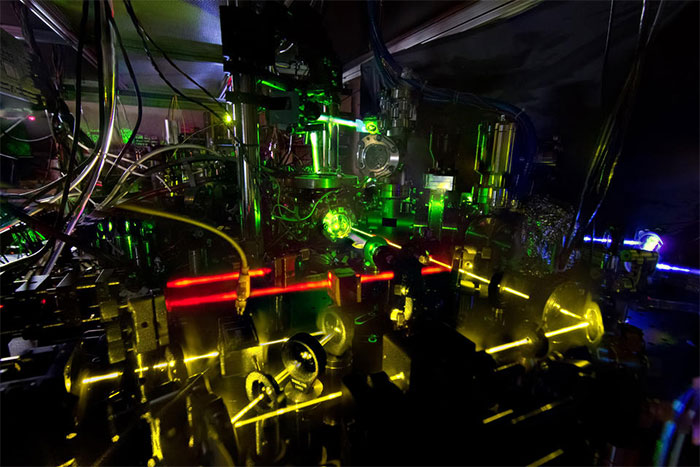If you ask which type of clock is the most accurate and has made a significant contribution to the development of humanity, it must undoubtedly be the atomic clock.
By basic definition, an atomic clock is a type of clock that measures time based on the oscillation states of atoms. In this case, the oscillation frequency of the atom is constant and measurable, making atomic clocks the most accurate timekeeping devices created by humans to date.
Thanks to their ability to operate with nearly absolute precision, these clocks are commonly used to measure time accurately, determine and coordinate time zones, and synchronize various time systems. Additionally, atomic clocks are employed in missile systems, drones, and particularly in measuring time to determine distances on satellites in positioning systems like GPS, GLONASS, or Galileo.
Typically, most atomic clock systems operate based on cesium atoms. However, the most modern atomic clock developed by the National Institute of Standards and Technology (NIST) operates based on a crystal network of ytterbium atoms, making it the most accurate and stable atomic clock system in the world today.
When discussing atomic clocks, stability refers to the consistency of the time of each tick on the clock. Ytterbium has a ticking rate that can reach trillions of ticks per second. Furthermore, each tick must be extremely precise; if one tick is too fast while others are too slow, the overall accuracy of the clock will be affected. Even if discrepancies cancel each other out over seconds or minutes, the smallest deviations can lead to less effective clock performance at the millisecond or nanosecond scale.
Ytterbium is an atom with extremely high stability; therefore, ytterbium atomic clocks achieve accuracy surpassing the nanosecond range, extending to the picosecond (1/1000 of a second) and femtosecond (1/1,000,000,000,000,000,000 of a second) levels. However, scientists at NIST aim to push these boundaries even further.

NIST Ytterbium Atomic Clock.
Dead Time = 0
Atomic clocks measure time based on the number of oscillations of atoms. In other words, atomic clocks function by stimulating the electrons of the atom to jump from lower energy levels to higher ones and vice versa. The electrons emit electromagnetic waves at very specific frequencies, using the oscillation cycle of these waves as a reference for measuring time.
For instance, in a cesium atomic clock with the stable isotope 133Cs, it can be simply understood that in one second, a Cesium-133 atom (133Cs) will transition between two energy states 9,192,631,770 times.
However, one of the issues with atomic clocks is “dead time.” Typically, atomic clocks alternate between adjusting time intervals and dead times, during which the atoms in the sample are prepared for another measurement. During dead time, small fluctuations in the laser can slightly affect the measurements, making the clock less accurate.
To tackle this issue, scientists at NIST have developed what they call a dual clock, which coordinates two separate atomic clocks. In this setup, the two clocks alternate adjusting their counting rhythms and dead times so that one of the lasers is always in the most accurate state and can be flexibly adjusted at any time. This effectively eliminates the problem of dead time.
NIST scientists believe that their design could be used to create smaller, more portable atomic clock systems in the future. Currently, NIST’s combined clock system is larger than a regular clock, but the two clocks can share many components, making the overall structure not overly complex.
Such stable atomic clocks can be deployed worldwide to accurately map the Earth’s gravitational field or sent on planes or into space to test general relativity, aiding scientists in studying the fundamental constants of the universe and conducting even more complex scientific discoveries.

















































